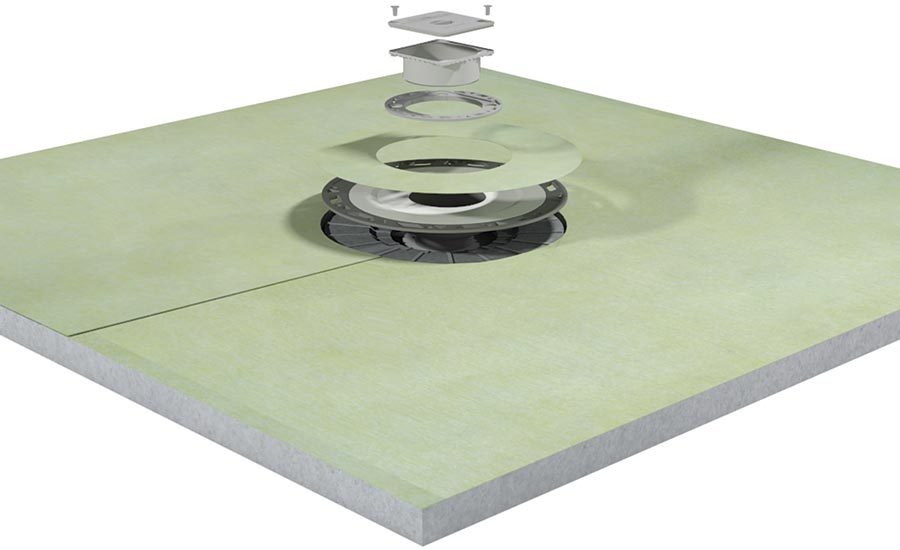Understanding Sealed vs. Water In, Water Out Shower Assemblies

An integrated flange provides waterproofing at the surface as opposed to underneath.
Photo courtesy of Profilitec.

Profilitec’s Showertec sealed system.
Photo courtesy of Profilitec.

Detail B421 from the 2017 TCNA Handbook, illustrating water in, water out assemblies.
Courtesy of Tile Council of North America.



About 20 years ago, my wife and I were shopping for a new home. We had spent 10 years in our first home and with kids on the way and the career path somewhat settled, we thought the time was right to get a bigger house. It was our belief that our “ideal” home would be one where we would have a say in the choice of finishes, colors, materials, etc., which led us to focus on new home construction projects being developed in our area as opposed to an existing home. While my wife focused on the overall design, the layout of the rooms and which direction the house would be positioned in relation to where the sun came up in the morning, I—being born and raised in the tile industry—focused mostly on flooring and how the bathrooms were to be constructed.
Having been in the tile trade for 15 years at that point and working in a company that focused on tile installation systems, I judged builders based on the tile choices provided and—more specifically—the installation methods used. I gave high marks to those who offered updated and better quality tiles but the highest marks went towards more advanced installation methods. For example, low marks if the tile on the kitchen floor was set directly to the plywood, and high marks if they used an uncoupling system.
However, what struck me time and time again among the hundreds of builder’s model homes that we viewed, regardless of where that home would sit on the pricing scale (we did visit some really high-end homes, just to dream), none of them offered fully tiled showers. Every builder offered some sort of acrylic or fiberglass shower enclosure which I associated with low-end track home construction. This was so prevalent that I would ask each builder why tiled showers were not part of the offering. Every one of these builders responded in the same way: tiled showers were a major problem area.
Our search for our new home coincided with a time where I frequently traveled and noticed that these plastic enclosures were popping up in many of the updates of the major hotel chains, replacing what was once a tile installation. I posed the same question to some of the spec writers of these national accounts and their response was similar to those of the builders: tiled showers are problem areas requiring a lot of repairs and maintenance. These builders and architects would talk about leaks, mold development, lack of skilled labor, cost, time, etc., as deterrents to using tile.
We in the tile trade considered this very concerning as losing showers in new home construction, multifamily and hospitality segments to other products would be a major blow to tile consumption, particularly since one of the more popular trends in construction, both residentially and in hospitality was to replace bathtubs with showers.
As such, the purpose of tile installation systems companies, such as the one where I was employed at the time, is to provide solutions to tile installation problems and encourage the consumption of tile. Therefore, since a significant and important portion of the market perceived tile showers as a problem area, we took it upon ourselves to find out why. Doing so required a full analysis of how tiled showers were constructed, identification of the problem areas and the development of appropriate systems and/or products to resolve the issue.
The industry-accepted construction method outlined in the Tile Council of North America (TCNA) Handbook for tiled showers is detail B421. This is known as the “water in, water out” method. This assembly is based on the concept that moisture management occurs both on the surface of the tile as well as beneath it.
The assembly requires a traditional plumbing industry-recognized pan liner to be clamped to the base portion of the two-component drain. The liner has been placed on top of a mortar layer that has been sloped toward the drain. Another mortar layer is placed on top of the liner and tile is then set to the mortar layer. A mortar bed installation is necessary on top of the pan liner because the liners are thick and compressible and could not support tile.
This rather complicated assembly is based on the concept that the water—which penetrates into the mortar layer through grout joints—will travel to the pan liner. Because the liner is on a sloped bed toward the base portion of the two-component drain with weep holes, water will then drain out of the mortar bed.
There are many more steps and aspects which need to be respected for this assembly to function that are too detailed to outline here, but it is an assembly that has served the industry well for many, many years. However, during our research on problems associated with traditional tile shower assemblies, one of the primary issues was that the skill level and knowledge base in the tile trade is diminishing and these assemblies are not being built correctly.
Missing a step or component in this type of assembly can cause major problems. For instance, in our research we found that few installers were including a pre-slope beneath the liner. This prevents correct moisture flow, defeating the purpose of the system and resulting in a saturated mortar bed. Nailing through the liner, or not properly addressing inside and outside corners, causes leaks. Not providing elements to keep the weep holes clear also contributes to the saturation of the mortar bed. The bottom line is that this type of assembly is very detailed, requires a certain skill level and knowledge base, and omitting even one step can lead to failure.
Because of the facts regarding traditional “water in, water out” assemblies, our analysis led us to believe that the solution must be simple and time-efficient to match today’s construction realities while at the same time, perform to a higher standard. Our analysis indicated that the majority of the problems, both from a functional and practical standpoint, were associated with allowing water to penetrate the mortar bed under the tile.
The skill and knowledge level required to build a multi-step functioning “water in, water out” assembly is perhaps more than what is generally available and mistakes are common, leading to failures. Therefore, we felt that the solution was to keep the mortar bed dry and apply the waterproof materials on top of the mortar bed, not beneath it. However, traditional two-component drains were not compatible with thin, bondable waterproof materials; hence the development of the integrated bonding flange and the birth of “sealed” shower systems.
As opposed to traditional “water in, water out” assemblies where the waterproof liner is beneath the mortar layer, “sealed” shower systems incorporate thin, bondable waterproofing membranes that are installed on top of the mortar layer, making sure it remains dry. An “integrated bonding flange” is specifically designed to allow thin, bondable membranes (whether sheet- or trowel-applied) to be bonded on its flange.
Understandably, a “sealed” system is a significantly simpler assembly that reduces installation time by eliminating many steps compared to traditional “water in, water out” assemblies. Since the waterproofing material is on the surface of the mortar layer and not beneath, there is no need for a pre-slope mortar layer, a thick pan liner or a two-stage drain. Further, because moisture management occurs above the mortar layer, time-saving elements such as pre-fabricated foam shower trays and curbs can now be used—making installation even simpler and faster.
Since these systems have come in to the market about 20 years ago, improvements have been made such as the availability of pre-waterproofed shower trays and curbs, saving significant time and making installation even easier and faster. Also, as showers are becoming larger, incorporating multiple heads, steam elements, etc., it is now necessary to take note of your installation system’s ability to manage vapor. Vapor infiltration can be as damaging to building elements as a water leak.
According to statistics, there are approximately five million showers being installed every year in the US, either new or as a replacement of a bathtub. “Sealed” systems have made the process to build a shower less labor-intensive and skill-dependent, resulting in more reliable performance. I am pleased to say that I now see tiled showers being offered in new home construction and in the hospitality segment.
Looking for a reprint of this article?
From high-res PDFs to custom plaques, order your copy today!











